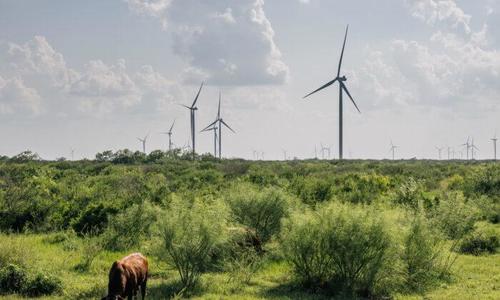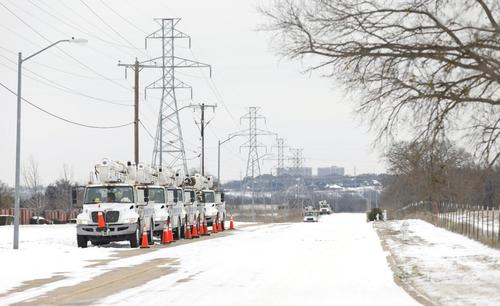Texas Relies More On Wind Than Coal For Its Energy... But Is It Ready For Another Winter Storm?
Authored by Darlene McCormick Sanchez via The Epoch Times,
Texas power regulators announced significant changes in December focused on shoring up problems with its electricity grid that narrowly escaped a catastrophic total blackout when Winter Storm Uri hit in February.
With natural gas generating most of the state’s electricity, much of the talk has focused on how to make sure natural gas providers and generators are prepared against freezing and supply issues should another storm like Uri sweep through Texas.
But little has been said about what wind power - the second-largest producer of energy for Texas’ independent grid - will do to winterize to keep the grid stable in an emergency, even as some wonder why Texas, rich in fossil fuels, is relying so heavily on wind in the first place.
Wind turbines are viewed at a wind farm in Colorado City, Texas, on Jan. 21, 2016. (Spencer Platt/Getty Images)
The Texas grid, unique in its independence from the rest of the country, is managed by the Electric Reliability Council of Texas, which is governed by the Public Utility Commission of Texas.
The grid is powered mainly by natural gas, which generated 46 percent of the electricity in 2020. But the grid’s share of renewable power has been increasing over the past decade, with wind providing 23 percent, surpassing coal which supplies 18 percent. Another 11 percent is supplied by nuclear, and the remainder comes from other sources.
All sectors of the grid struggled to supply electricity during the storm that contributed to more than 200 deaths and cost the state billions in financial losses.
In an email response to The Epoch Times, Mike Hoke, a public utility spokesman, said wind power producers were not exempt from winterization rules mandated by state regulators in wake of Uri.
Wind farms had to implement weather emergency preparation measures intended to ensure the sustained operation of all cold weather critical components during winter weather conditions and provide training, according to an email from ERCOT Corporate Communications.
Additionally, wind power CEOs or Texas leaders were required to submit attestations to ERCOT by Dec. 1 regarding their winterization efforts in the same way that leaders of conventional resources such as natural gas did, according to ERCOT.
Jennifer Garber, a spokeswoman for Duke Energy, which runs the Sweetwater Wind Farm in Nolan County, Texas, said in an email that their wind turbines performed within expectations during Uri.
“Since February, we have reviewed our operational winterization procedures and our Texas renewable resources met the requirements as outlined by the Texas PUC,” she wrote.
Criticism has been leveled at wind power’s performance during the deep freeze due to ice accumulation on turbine blades and frozen gear-boxes hindering or stopping production—something that doesn’t happen in wind farms in northern states and countries such as Canada.
Josh Rhodes, an energy expert with the Webber Energy Group at the University of Texas, Austin, said during an interview with The Epoch Times that retrofitting Texas wind farms to deal with freezing could be costly.
People seeking shelter from sup-freezing temperatures gather at a make-shift warming shelter at Travis Park Methodist Church in San Antonio, Texas, on Feb. 16, 2021. (Eric Gay/AP Photo)
“It is pretty expensive to retrofit,” he said, adding there are probably 10,000 to 15,000 wind turbines in Texas.
Wind turbines can be outfitted with cooling or heating equipment that can be placed in the gear-boxes on turbines, Rhodes said, but added that some turbines may not be designed to accommodate both systems.
That would leave a few other options, such as adding heating strips to turbine blades to keep them ice-free just like a defroster in a car windshield, or coating the blades with a Teflon-like substance, he added.
“If they can add that coating after the fact, that would probably be one of the cheapest options,” Rhodes said.
Another method he heard that was actually used in some Texas wind farms was to get the blades spinning and then throw the brake which would sometimes shake the ice off.
But even if wind farms are fully protected against cold weather, there is apprehension that Texas’ growing reliance on wind energy could cause trouble down the road. If enough wind power drops off the grid in just a few minutes, there wouldn’t be enough time for thermal plants to power up to take up the slack.
While on national television, Texas Gov. Greg Abbott (R), for example, emphasized renewable energy’s failure during the storm.
“Our wind and our solar got shut down,” Abbott said during a February appearance on Sean Hannity’s Fox News show.
“It just shows fossil fuel is necessary for the state of Texas as well as other states to make sure we will be able to heat our homes in the wintertime and cool our homes in the summertime.”
Pike Electric service trucks line up after a snowstorm in Fort Worth, Texas, on Feb. 16, 2021. (Ron Jenkins/Getty Images)
Despite the blowback against renewable energy, the Texas legislature actually stripped language from Senate Bill 3 this spring, which addressed the grid crisis, that would have added incentives for natural gas-fired power plants.
For David Blackmon, an independent energy analyst and consultant based in Mansfield, Texas, that omission from the bill was a missed opportunity for the state to stabilize its grid.
“Unfortunately ERCOT has fallen into the trap of relying on wind energy,” Blackmon said, adding that climate change politics has impacted Texas’ grid.
“It’s such a strange thing to me,” he said. “It’s as if no one takes a step back and says: What are we doing here? At what point does Texas become like California?”
Cows stand in a field on the ranch of cattle rancher Bob Helmers, who recently allowed utility company Engie to build several wind turbines on his land near Eldorado, Texas, on April 16, 2021. (Sergio Flores /AFP via Getty Images)
Jason Modglin, president of Texas Alliance of Energy Producers, echoed those concerns, saying that it was natural gas that took on the lion’s share of the load when wind power dropped off during Uri.
“Natural gas ramped up 400 percent in February, but we needed it to ramp up 500 percent,” said Modglin.
Modglin added that only a few peaker gas plants—those that are used in emergencies—have been built in the last decade and coal-burning plants are being phased out in Texas.
“The money has been chasing wind and solar,” Modglin said.
Source: Zerohedge











